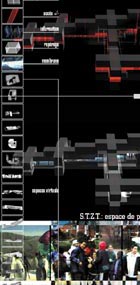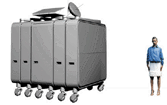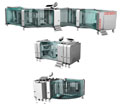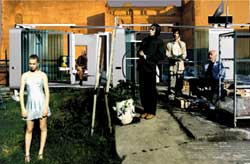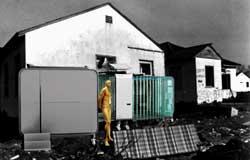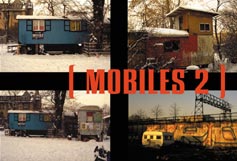Grégoire & Petetin
| Philippe Grégoire (*1963) | Claire Petetin (*1963)
In
1995 Philippe Grégoire & Claire Petetin opened their agency
in Paris, and won the "L'Envers des Villes" prize with their study of
a portable dwelling for new urban nomads in Berlin ("The Portable House").
Since then, they have had nonstop thoughts about future prospects for
cities, the future of the built-up setting, and the future of the dwelling
and habitat, through specific ways of continuing the city. They question
the possible solutions in a transversal way, linking their philosophical
issues to an analysis of the social landscape. Their work thus seems to
be partly inspired by the issues raised by Deleuzian deterritorialization.
At once inquisitive and resolute, they endow this research, at whose hub
they put the inhabitant, with the forcefulness of experimenting with new
communications techno-logies. For Philippe Grégoire and Claire
Petetin, these are "the most interesting artefact insomuch as they represent
one of the major signs of the identity of our contemporary society", but
they are also one of the instruments in the growing rift between "favoured"
urban places—favoured by being equipped and directly hooked into
the development of society—and other "neglected" parts, on the fringes
of society. So for the first time they are tackling a different line of
thin-king about the constructed object with this Portable House project,
which conjures up David Greene's "Living Pod", made within Archigram,
just as much as that age-old tradition of the "Rollheimers" or "caravan
people", from which Philippe Grégoire and Claire Petetin have drawn
their inspiration. The portable house is conceived as a technological
extension of the person and his senses : it puts people very close to
the original isotropic space of the metropolis, nowadays transformed into
an infinite host of spatially scattered micro-spaces. Philippe Grégoire
and Claire Petetin thus capsize static and peren-nial geographical inscriptions
by coming up with temporary shelters with many variable and ephemeral
functions. The following year, in 1996, they set up the Time/Zone association,
based in Paris. Here, new communications technologies are used to draw
a real territory, usually in a state of crisis, closer to a virtual territory.
The three "Second Time Zone" projects thus experiment with the urban,
architectural and social possibilities of this linkage in order to redefine
an existing territory suitable for unifying and creating new places of
expression, rights and freedoms. With great coherence, Philippe Grégoire
and Claire Petetin are working today on establishing their Portable House
as a programming then development platform for the "STZT" programmes within
the sites at St. Ouen, Pantin and Kobe.
A prototype of this Portable House is being constructed for the ICC exhibition
in Tokyo.


